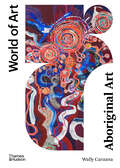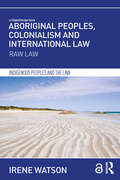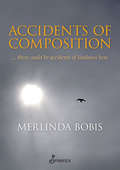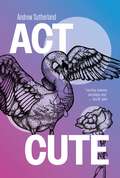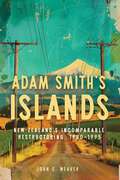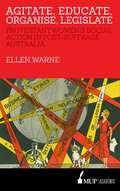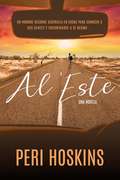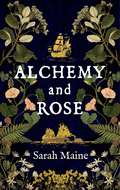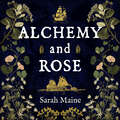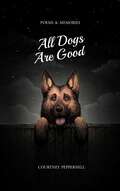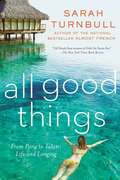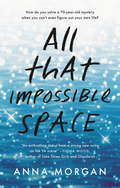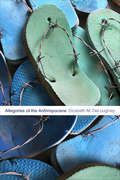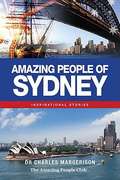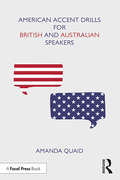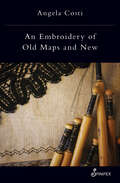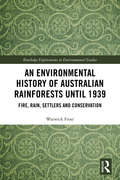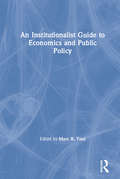- Table View
- List View
Aboriginal Art (World of Art)
by Wally CaruanaAn updated and expanded edition of this classic survey, which has established itself as a superlative introduction to the full diversity of Aboriginal art. This concise survey showcases the incredible, diverse work of Aboriginal and Torres Strait artists. Building on traditions that stretch back at least 50,000 years, these artists have long worked in a variety of contexts from the sacred and secret realm of ceremony to more public spheres. From isolated beginnings to postcolonialism and the present, Wally Caruana explains how Aboriginal and Torres Strait Islander art has continually developed and responded to change; and considers the impact of urban living, the growth of local art centers that support the artists in these communities, and the recognition of women artists. This new edition has been expanded and updated to include and reflect on important artists who have emerged in the last decade, with a focus on the burgeoning of activity in the Southern Desert region, Queensland, and the Torres Strait Islands—all testament to Aboriginal art’s continued dynamism and vitality.
Aboriginal Art and Australian Racial Hegemony: Decolonising Consciousness
by Abraham BradfieldThis book explores the complexities of Indigenous and non-Indigenous relations in contemporary Australia. It unpacks the continuation of a pervasive colonial consciousness within settler-colonial settings, but also provokes readers to confront their own habits of thought and action. Through presenting a reflexive narrative that draws on the author’s encounters with Indigenous artists and their artwork, knowledge, stories, and lived experiences, this provocative and insightful work encourages readers to consider what decolonising means to them. It presents a compelling and relevant argument that calls for a reorientation of dominant discourses fixed within Eurocentric frameworks, whilst also addressing the deep complexities and challenges of living within intercultural settler-colonial settings where different views and perspectives clash and complement one another.
Aboriginal Peoples, Colonialism and International Law: Raw Law (Indigenous Peoples and the Law)
by Irene WatsonThis work is the first to assess the legality and impact of colonisation from the viewpoint of Aboriginal law, rather than from that of the dominant Western legal tradition. It begins by outlining the Aboriginal legal system as it is embedded in Aboriginal people’s complex relationship with their ancestral lands. This is Raw Law: a natural system of obligations and benefits, flowing from an Aboriginal ontology. This book places Raw Law at the centre of an analysis of colonisation – thereby decentring the usual analytical tendency to privilege the dominant structures and concepts of Western law. From the perspective of Aboriginal law, colonisation was a violation of the code of political and social conduct embodied in Raw Law. Its effects were damaging. It forced Aboriginal peoples to violate their own principles of natural responsibility to self, community, country and future existence. But this book is not simply a work of mourning. Most profoundly, it is a celebration of the resilience of Aboriginal ways, and a call for these to be recognised as central in discussions of colonial and postcolonial legality. Written by an experienced legal practitioner, scholar and political activist, AboriginalPeoples, Colonialism and International Law: Raw Law will be of interest to students and researchers of Indigenous Peoples Rights, International Law and Critical Legal Theory.
Aboriginal Peoples, Colonialism and International Law: Raw Law (Indigenous Peoples and the Law)
by Irene WatsonThis work is the first to assess the legality and impact of colonisation from the viewpoint of Aboriginal law, rather than from that of the dominant Western legal tradition. It begins by outlining the Aboriginal legal system as it is embedded in Aboriginal people’s complex relationship with their ancestral lands. This is Raw Law: a natural system of obligations and benefits, flowing from an Aboriginal ontology. This book places Raw Law at the centre of an analysis of colonisation – thereby decentring the usual analytical tendency to privilege the dominant structures and concepts of Western law. From the perspective of Aboriginal law, colonisation was a violation of the code of political and social conduct embodied in Raw Law. Its effects were damaging. It forced Aboriginal peoples to violate their own principles of natural responsibility to self, community, country and future existence. But this book is not simply a work of mourning. Most profoundly, it is a celebration of the resilience of Aboriginal ways, and a call for these to be recognised as central in discussions of colonial and postcolonial legality.Written by an experienced legal practitioner, scholar and political activist, AboriginalPeoples, Colonialism and International Law: Raw Law will be of interest to students and researchers of Indigenous Peoples Rights, International Law and Critical Legal Theory.The Open Access version of this book, available at http://www.taylorfrancis.com, has been made available under a Creative Commons [Attribution-Non Commercial-No Derivatives (CC BY-NC-ND)] 4.0 license.
Accidents of Composition
by Merlinda BobisIs it the sun a hole sucking in a bird or Icarus about to singe the sun? Which composes which? The poet asks as she circumnavigates the globe, history, and an inner universe. When it responds, there's the small shudder, the sprawl of a spin, or the quiet before and after a full circle. The eyes catch a black bird close to an eerie sun. Instantly, a poem: an accident of composition. Or a tree, rock, light from a story heard, dreamt, read or remembered returns as if it were the only tree, rock, light in the planet. The poet is caught, returned to her first heart: poetry. After four novels, Merlinda offers poems from the stillness of contemplation to the spinning of tales, then to passage across different histories. Glass becomes eternal greens underwater, fish gossip about colonisation, a gumnut turns dissident, and the dreams of Captain Cook and Pigafetta circumnavigate the globe leaving a trail of blood, beads, and the scent of cloves. But in between, the poet hopes: ‘there could be accidents / of kindness here.'
Act Cute: Queer POZ poetry
by Andrew SutherlandThe second poetry collection from Queer Poz (PLHIV) writer and performance-maker. In Act Cute, the poet addresses the gap between memory and the present, and asks how to perform a coherent self amidst the forces of nostalgia, institutional entanglements and reckonings, and queer desiring. Shifting between autofictive address and canonical personae, the structural codes of romantic drama uneasily frame the poet-as-actor through five sections, titled 'Audition Sides', 'you stop me at the airport and tell me that you love me', 'twink death in Europa!!', 'Wedding Scenes' and 'forgiveness'.
Adam Smith’s Islands: New Zealand’s Incomparable Restructuring, 1980–1995
by John C. WeaverMany developed countries restructured relations between state and economy from the late 1970s into the 1990s. Among them, New Zealand went far, fast, and left a clear trail, making it possible to study economic restructuring as it occurred, with all the debates, uncertainty, surprises, mistakes, and accomplishments this entailed. Adam Smith’s Islands reveals the inside life of a government determined to revolutionize its nation’s politics and economy.While the 1980s economic restructuring of members of the Organisation for Economic Co-operation and Development and former Warsaw Pact countries can seem like a foregone conclusion from the vantage point of the twenty-first century, John Weaver examines how local and global institutions had to come together to implement social adjustments in New Zealand. Mounting evidence that the state had not functioned as an effective manager split the business community and primary producers between defenders of subsidization and free-market insurgents. Reforms undertaken by the governing Labour Party included abandoning currency controls, privatizing state-run businesses, ending a multitude of open and disguised subsidies, tightening fiscal responsibility, and reforming taxation. Adam Smith’s Islands focuses on the verifiable: direct primary sources from dozens of state collections and deposits of personal papers. The archival cornucopia informing this history supports a narrative that has little in common with intellectual histories of neoliberalism. To understand how the relationship between the economy and the state changed, we need to grasp how and why core institutions, practices, and cultural beliefs shed some of their once potent legitimacy.Through the lens of New Zealand, Adam Smith’s Islands examines larger questions about policy dilemmas, the global flow of capital, and the sustainability of social adjustments in economic restructuring. In so doing, it casts new light on the formation and history of what is casually labelled today as the neoliberal state.
Advancing Australia: Ideas for a Better Country
by John Watson Amanda DunnPolitics in Australia is in a dire state. The Coalition government is led by its third prime minister in four years, two of whom were toppled by their own party. Before that, the Labor government ousted two prime ministers. Voters' trust in politicians is at an all-time low, there is policy inertia on key issues, and ideology and internal politics too often trump good government. We have the diagnosis, but what's the cure? In this collection of essays, the country's best academic minds look at the key issues and chart a way forward. They examine how Australia's taxation system could be fairer; the priorities in progressing Indigenous Australians' rights; the absurdity of the constant 'left versus right' debate; how to fix private health insurance; and how to settle the conflict between population and migration policies. Here are innovative and bold ideas to advance Australia.
Agitate, Educate, Organise, Legislate: Protestant Women's Social Action in Post-Suffrage Australia
by Ellen WarneAfter successfully agitating for the vote for women from the 1890s, Protestant women's organisations in Australia began to educate women at a grassroots level on effective ways of applying political pressure on a wide range of topics and social concerns. Positioning their organisations as non-party-political and separate from more overtly feminist groups, the Woman's Christian Temperance Union (WCTU); the Young Women's Christian Association (YWCA) and the Mothers' Union attracted women who were keen to work for change, and who were seeking to 'save' the individual as well as the greater society. These three organisations sought to agitate on a wide range of issues related to girls and women, connecting with public anxieties and highlighting particular vulnerabilities of girls and young women who lived alone in the city and had the potential to be exploited in the workforce. By the 1920s and 1930s these women's groups noted with concern the easier access to divorce and birth control in the Soviet Union and the growing influence of both Communism and 'Hitlerism' in galvanising young people. Agitate, Educate, Organise, Legislate explores the colourful debates and anxieties that were prevalent from the 1890s to the 1930s and the responses of the key women's organisations whose leadership and campaigns acknowledged that—outside of parliament and party politics—women's connection to political matters could be both innovative and socially influential.
Al Este - Una novela
by Peri Hoskins"...en una palabra: extraordinario.” V. Scipione, Agente Literario norteamericano. "Su forma de escribir es magnífica… Si hay algún escritor que me recuerde a Hoskins, ese sería John Steinbeck. Pero en vez del norte de California y el Valle de Salinas, descubrimos Australia y Nueva Zelanda.” - R. Simmons, de Readers’ Favorite. "... El resultado es una historia en la carretera donde se producen descubrimientos y conexiones entre personas, elevándolas a un nuevo nivel de introspección y crecimiento, de forma que ‘Al Este’ se convierte en una novela altamente recomendable para lectores a los que les gustan las historias introspectivas y las aventuras, y a los que consideran la experiencia de viajar por carretera como un estímulo a la hora de tomar decisiones.” - D. Donovan, Crítico autorizado, Midwest Book Review "Este es un libro que termina haciendo que me cuestione mi propia vida y hacia dónde se dirige- que me haga preguntarme cómo podría yo cambiar mi rutina por algo mucho más excitante.” - Christine Frayling, Asociación de libreros de Nueva Zelanda. "Qué captura tan extraordinaria de una humanidad desnuda y sin adulterar, con todos sus matices, sus luces y sus sombras. Lo leí en muy poco tiempo, no podía dejar de hacerlo… De verdad, de verdad que disfruté de la lectura muchísimo.” - Teresa Herleth Lleva una vida ordenada. Trabaja duro. Paga tus impuestos. Poda tu césped. Sé un buen ciudadano. Vince Osbourne ha llevado una vida ordenada durante treinta años. Ya es hora de ponerse en marcha. Frente a él se encuentra el enorme continente australiano, un futuro incierto y un pasado sin resolver. Al tiempo que recorre los enormes y cambiantes paisajes del país, Vince aprende a apreciar su belleza, sus peligros y, sobre todo, a sus gentes. Encuentros con jóvenes amantes, viejos amigos, bellas mujeres, aborígenes, un pescador sin rumbo por el desierto y un vapuleado ex
Alchemy and Rose: A sweeping new novel from the author of The House Between Tides, the Waterstones Scottish Book of the Year
by Sarah MaineA beautiful and sweeping historical novel that takes the reader from the west coast of New Zealand, to Scotland and Melbourne in the 1870s1866. Will Stewart is one of many who have left their old lives behind to seek their fortunes in New Zealand's last great gold rush. The conditions are hostile and the outlook bleak, but he must push on in his uncertain search for the elusive buried treasure.Rose is about to arrive on the shores of South Island when a storm hits and her ship is wrecked. Just when all seems lost she is snatched from the jaws of death by Will, who risks his life to save her. Drawn together by circumstance, they stay together by choice and for a while it seems that their stars have finally aligned.But after a terrible misunderstanding they are cruelly separated, and their new-found happiness is shattered. As Will chases Rose across oceans and continents, he must come to terms with the possibility that he might never see her again. And if he does, he will have to face the man who took her . . .
Alchemy and Rose: A sweeping new novel from the author of The House Between Tides, the Waterstones Scottish Book of the Year
by Sarah MaineA beautiful and sweeping historical novel that takes the reader from the west coast of New Zealand, to Scotland and Melbourne in the 1870s1866. Will Stewart is one of many who have left their old lives behind to seek their fortunes in New Zealand's last great gold rush. The conditions are hostile and the outlook bleak, but he must push on in his uncertain search for the elusive buried treasure.Rose is about to arrive on the shores of South Island when a storm hits and her ship is wrecked. Just when all seems lost she is snatched from the jaws of death by Will, who risks his life to save her. Drawn together by circumstance, they stay together by choice and for a while it seems that their stars have finally aligned.But after a terrible misunderstanding they are cruelly separated, and their new-found happiness is shattered. As Will chases Rose across oceans and continents, he must come to terms with the possibility that he might never see her again. And if he does, he will have to face the man who took her . . .
Alchemy and Rose: A sweeping new novel from the author of The House Between Tides, the Waterstones Scottish Book of the Year
by Sarah Maine1866. Will Stewart is one of many who have left their old lives behind to seek their fortunes in New Zealand's last great gold rush. The conditions are hostile and the outlook bleak, but he must push on in his uncertain search for the elusive buried treasure.Rose is about to arrive on the shores of South Island when a storm hits and her ship is wrecked. Just when all seems lost she is snatched from the jaws of death by Will, who risks his life to save her. Drawn together by circumstance, they stay together by choice and for a while it seems that their stars have finally aligned.But after a terrible misunderstanding they are cruelly separated, and their new-found happiness is shattered. As Will chases Rose across oceans and continents, he must come to terms with the possibility that he might never see her again. And if he does, he will have to face the man who took her . . .(P) 2021 Hodder & Stoughton Ltd
All Dogs Are Good: Poems & Memories
by Courtney PeppernellWritten for anyone who has known the touch of a cold nose on their hand, the bark of a best friend, or the joy of a walk accompanied by a wagging tail, All Dogs Are Good pays tribute to the special bond we share with our canine companions.Filled with heartfelt poems and prose on the love, dedication, and laughter our dogs bring, as well as the unique lessons they teach us along the way, bestselling author Courtney Peppernell&’s vignettes of life with our dogs are a touching reminder of the gifts they give us during their journey on earth. Celebrating dogs everywhere, All Dogs Are Good is a collection dog lovers will hold in their hearts forever.
All Good Things
by Sarah TurnballIn this lushly written follow-up to Almost French, Sarah Turnbull explores a new paradise: Tahiti. Having shared her story in her bestselling memoir, Almost French, Australian writer Sarah Turnbull seemed to have had more than her fair share of dreams come true. While Sarah went on to carve out an idyllic life in Paris with her husband, Frederic, there was still one dream she was beginning to fear might be impossible—starting a family. Then out of the blue an opportunity to embark on another adventure offered a new beginning—and new hope. Leaving behind life in the world’s most romantic and beautiful city was never going to be easy. But it helps when your destination is another paradise on earth: Tahiti.
All That Impossible Space
by Anna MorganAmelia Westlake meets My Favorite Murder in this debut from a terrific new voice in Australian YA. Combines a realistic story about high school drama and toxic friendship with true crime - the endlessly fascinating Somerton Man or Taman Shud mystery.15-year-old Lara Laylor feels like supporting character in her own life. She's Ashley's best friend, she's Hannah's sister-she's never just Lara. When new history teacher Mr. Grant gives her an unusual assignment: investigating the mystery of the Somerton Man. Found dead in on an Adelaide beach in 1948, a half-smoked cigarette still in his mouth and the labels cut out of his clothes, the Somerton Man has intrigued people for years. Was he a spy? A criminal? Year 10 has plenty of mysteries of its own: boys, drama queen friends, and enigmatic new students. When they seem just as unsolvable as a 60-year-old cold case, Lara finds herself spending more and more time on the assignment. But Mr Grant himself may be the biggest mystery of all...Interspersed with fictionalised snapshots of the Somerton Man investigation, ALL THAT IMPOSSIBLE SPACE is a coming of age novel exploring toxic friendships and the balance of power between teacher and student, perfect for fans of Cath Crowley and Fiona Wood.
All Things Harmless, Useful, and Ornamental: Environmental Transformation through Species Acclimatization, from Colonial Australia to the World (Flows, Migrations, and Exchanges)
by Pete MinardSpecies acclimatization--the organized introduction of organisms to a new region--is much maligned in the present day. However, colonization depended on moving people, plants, and animals from place to place, and in centuries past, scientists, landowners, and philanthropists formed acclimatization societies to study local species and conditions, form networks of supporters, and exchange supposedly useful local and exotic organisms across the globe. Pete Minard tells the story of this movement, arguing that the colonies, not the imperial centers, led the movement for species acclimatization. Far from attempting to re-create London or Paris, settlers sought to combine plants and animals to correct earlier environmental damage and to populate forests, farms, and streams to make them healthier and more productive. By focusing particularly on the Australian colony of Victoria, Minard reveals a global network of would-be acclimatizers, from Britain and France to Russia and the United States. Although the movement was short-lived, the long reach of nineteenth-century acclimatization societies continues to be felt today, from choked waterways to the uncontrollable expansion of European pests in former colonies.
Allegories of the Anthropocene
by Elizabeth M. DeLoughreyIn Allegories of the Anthropocene Elizabeth M. DeLoughrey traces how indigenous and postcolonial peoples in the Caribbean and Pacific Islands grapple with the enormity of colonialism and anthropogenic climate change through art, poetry, and literature. In these works, authors and artists use allegory as a means to understand the multiscalar complexities of the Anthropocene and to critique the violence of capitalism, militarism, and the postcolonial state. DeLoughrey examines the work of a wide range of artists and writers—including poets Kamau Brathwaite and Kathy Jetñil-Kijiner, Dominican installation artist Tony Capellán, and authors Keri Hulme and Erna Brodber—whose work addresses Caribbean plantations, irradiated Pacific atolls, global flows of waste, and allegorical representations of the ocean and the island. In examining how island writers and artists address the experience of finding themselves at the forefront of the existential threat posed by climate change, DeLoughrey demonstrates how the Anthropocene and empire are mutually constitutive and establishes the vital importance of allegorical art and literature in understanding our global environmental crisis.
Amazing People of Australia - A Short eBook
by Charles MargerisonAustralia has developed to become a model multi-ethnic society. In this collection of life stories from The Amazing People Club, you can gain an insight into how some amazing Australians set the scene and contributed to the country we fondly refer to as Downunder. Embark on a thrilling flight of discovery with Charles Kingsford Smith. His courage, competitive spirit and daring sense of adventure led to him being regarded as one of the highest achievers in the history of aviation. Be inspired by the entrepreneurial talent of James Harrison who invented the refrigerator which has become a necessity in our homes of today. Be captivated by the tumultuous events in the life of Nellie Melba, a self-driven diva who achieved great success and became one of Australia's most celebrated sopranos of all time. Meet these and several other amazing Australians who in their own unique ways, seized opportunities that led to great successes. Each story comes to life through BioViews®. These are short biographical narratives, similar to interviews. They provide an easy way of learning about amazing people who made major contributions and changed our world.
Amazing People of Sydney
by Charles MargerisonImagine you had to sail 10,000 miles to an island in the South Pacific Ocean in an old wooden boat. In 1788, that happened to over 1400 English convicts, colonists, captains and men of the Marine Corps. Watched by fearful local Aboriginals, they established a base in a place called New South Wales, Australia. Who were these amazing people? How did they survive and build the great and beautiful city that we now call Sydney? A city tour unlike any other, Amazing People of Sydney brings you in touch with real people who have left us a legacy that we can explore. Travel through time and meet some of the amazing people who helped Sydney develop. Discover how Governor Arthur Phillip and Bennelong, the captured Aborigine, tried to build relations between the communities. Explore the lives of people including Francis Greenway, Mary Reibey and George Howe. All of them arrived in Sydney as convicts and through their tenacious spirit, grew to become some of the most significant figures in the city. Find out about William Tom's discovery of gold, and Captain Thunderbolt's great escape from Cockatoo Island. Be moved by the outstanding work of the tireless humanitarian, Caroline Chisholm, and her work with young women. Discover how Banjo Paterson wrote Waltzing Matilda. These stories, and many others, come alive through BioViews®. What is a BioView®? A BioView® is a short biographical story, similar to an interview. These unique stories provide an easy way of learning about amazing people who made major contributions and changed our world.
American Accent Drills for British and Australian Speakers
by Amanda QuaidAmerican Accent Drills for British and Australian Speakers provides a comprehensive guide to learning a "General American" accent, made specifically for native English speakers. Unlike most American accent guides, which are geared toward ESL learners, this handbook covers only the shifts that English speakers need to make – nothing more, nothing less. In addition to vowel and consonant drills, it covers the finer points of American intonation and elision, features that often elude English speakers of other dialects. Finally, it provides exercises for "owning" the dialect, finding authenticity and making it work for each individual actor in their own way. This is an excellent resource for students of speech and dialects, actors from the UK, Australia, and New Zealand, and advanced ESL learners who need to use an American accent on screen or on stage. American Accent Drills for British and Australian Speakers also includes access to downloadable audio files of the practice drills featured in the book, to help students practice and perfect their American accent.
Among Cannibals: An Account Of Four Years' Travels In Australia And Of Camp Life With The Aborigines Of Queensland
by Carl LumholtzCarl Lumholtz’s "Among Cannibals: An Account of Four Years' Travels in Australia and of Camp Life" is a riveting and detailed chronicle of the author’s extraordinary explorations in the remote regions of Australia during the late 19th century. This classic work offers a captivating insight into the diverse landscapes, cultures, and experiences encountered by Lumholtz during his extensive travels.Lumholtz, a renowned Norwegian explorer and ethnographer, embarked on his journey with the goal of studying the indigenous peoples of Australia, particularly those living in the most isolated and unexplored areas. His narrative vividly describes the challenges and triumphs of living in the Australian wilderness, from the dense rainforests of Queensland to the arid outback.Central to "Among Cannibals" is Lumholtz’s deep engagement with the Aboriginal communities he encounters. His empathetic and respectful approach to understanding their way of life, customs, and beliefs provides readers with a nuanced and humanizing portrayal of these cultures.Lumholtz’s narrative is not only a valuable ethnographic record but also an adventurous travelogue that captures the reader’s imagination. His encounters with wildlife, the natural beauty of the Australian landscape, and the everyday challenges of camp life are described with vivid detail and a keen sense of wonder."Among Cannibals" is a seminal work in the fields of anthropology and exploration, offering timeless insights into the lives of Australia’s indigenous peoples and the spirit of adventure that drove explorers like Lumholtz. This book remains an essential read for anyone interested in anthropology, Australian history, and the enduring allure of exploration.
An Embroidery of Old Maps and New
by Angela CostiI can see how I carry Yiayia's war in the ample dunes of my belly, the moment she smelt the guns, she pinched the candle's wick,gathered the startled shadows of her children,flung my baby-mother onto her backand sprinted towards the neutral moon—Migration and the memories of women's traditions are woven throughout these poems. Angela Costi brings the world of Cyprus to Australia. Her mother encounters animosity on Melbourne's trams as Angela learns to thread words in ways that echo her grandmother's embroidery. Here are poems that sing their way across the seas and map histories.
An Environmental History of Australian Rainforests until 1939: Fire, Rain, Settlers and Conservation (Routledge Explorations in Environmental Studies)
by Warwick FrostThis book provides a comprehensive environmental history of how Australia’s rainforests developed, the influence of Aborigines and pioneers, farmers and loggers, and of efforts to protect rainforests, to help us better understand current issues and debates surrounding their conservation and use. While interest in rainforests and the movement for their conservation are often mistakenly portrayed as features of the last few decades, the debate over human usage of rainforests stretches well back into the nineteenth century. In the modern world, rainforests are generally considered the most attractive of the ecosystems, being seen as lush, vibrant, immense, mysterious, spiritual and romantic. Rainforests hold a special place; both providing a direct link to Gondwanaland and the dinosaurs and today being the home of endangered species and highly rich in biodiversity. They are also a critical part of Australia’s heritage. Indeed, large areas of Australian rainforests are now covered by World Heritage Listing. However, they also represent a dissonant heritage. What exactly constitutes rainforest, how it should be managed and used, and how much should be protected are all issues which remain hotly contested. Debates around rainforests are particularly dominated by the contradiction of competing views and uses – seeing rainforests either as untapped resources for agriculture and forestry versus valuing and preserving them as attractive and sublime natural wonders. Australia fits into this global story as a prime example but is also of interest for its aspects that are exceptional, including the intensity of clearing at certain periods and for its place in the early development of national parks. This book will be of great interest to students and scholars of Environmental History, Australian History and Comparative History.
An Institutionalist Guide to Economics and Public Policy
by Marc R. ToolThis narrative recounts the 18th and 19th century "shipping out" of Pacific islanders aboard European and American vessels, a kind of "counter-exploring", that echoed the ancient voyages of settlement of their island ancestors.
